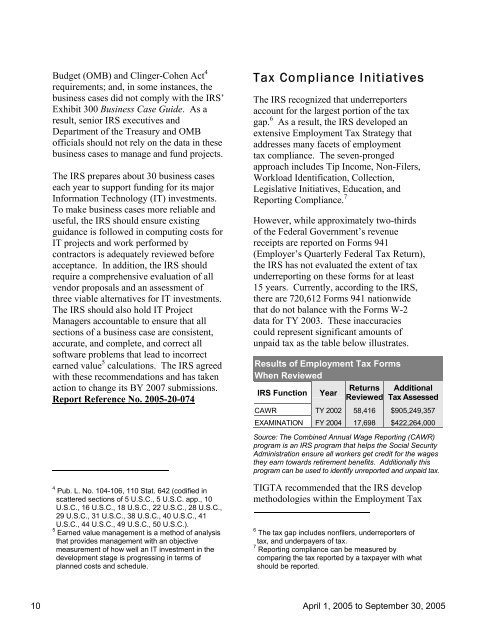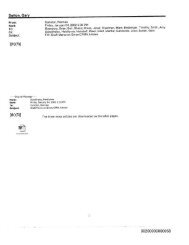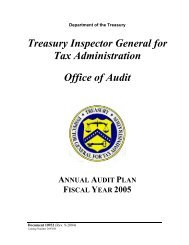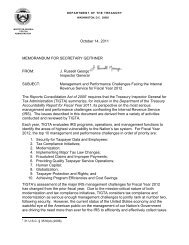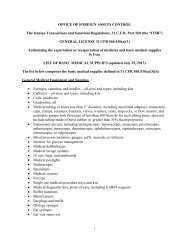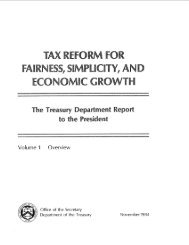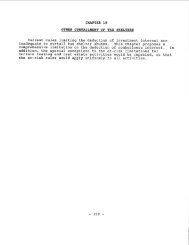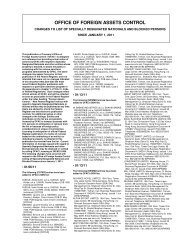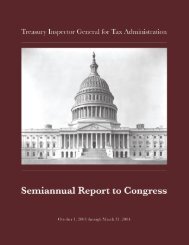PDF - Department of the Treasury
PDF - Department of the Treasury
PDF - Department of the Treasury
Create successful ePaper yourself
Turn your PDF publications into a flip-book with our unique Google optimized e-Paper software.
Budget (OMB) and Clinger-Cohen Act 4<br />
requirements; and, in some instances, <strong>the</strong><br />
business cases did not comply with <strong>the</strong> IRS’<br />
Exhibit 300 Business Case Guide. As a<br />
result, senior IRS executives and<br />
<strong>Department</strong> <strong>of</strong> <strong>the</strong> <strong>Treasury</strong> and OMB<br />
<strong>of</strong>ficials should not rely on <strong>the</strong> data in <strong>the</strong>se<br />
business cases to manage and fund projects.<br />
The IRS prepares about 30 business cases<br />
each year to support funding for its major<br />
Information Technology (IT) investments.<br />
To make business cases more reliable and<br />
useful, <strong>the</strong> IRS should ensure existing<br />
guidance is followed in computing costs for<br />
IT projects and work performed by<br />
contractors is adequately reviewed before<br />
acceptance. In addition, <strong>the</strong> IRS should<br />
require a comprehensive evaluation <strong>of</strong> all<br />
vendor proposals and an assessment <strong>of</strong><br />
three viable alternatives for IT investments.<br />
The IRS should also hold IT Project<br />
Managers accountable to ensure that all<br />
sections <strong>of</strong> a business case are consistent,<br />
accurate, and complete, and correct all<br />
s<strong>of</strong>tware problems that lead to incorrect<br />
earned value 5 calculations. The IRS agreed<br />
with <strong>the</strong>se recommendations and has taken<br />
action to change its BY 2007 submissions.<br />
Report Reference No. 2005-20-074<br />
Tax Compliance Initiatives<br />
The IRS recognized that underreporters<br />
account for <strong>the</strong> largest portion <strong>of</strong> <strong>the</strong> tax<br />
gap. 6 As a result, <strong>the</strong> IRS developed an<br />
extensive Employment Tax Strategy that<br />
addresses many facets <strong>of</strong> employment<br />
tax compliance. The seven-pronged<br />
approach includes Tip Income, Non-Filers,<br />
Workload Identification, Collection,<br />
Legislative Initiatives, Education, and<br />
Reporting Compliance. 7<br />
However, while approximately two-thirds<br />
<strong>of</strong> <strong>the</strong> Federal Government’s revenue<br />
receipts are reported on Forms 941<br />
(Employer’s Quarterly Federal Tax Return),<br />
<strong>the</strong> IRS has not evaluated <strong>the</strong> extent <strong>of</strong> tax<br />
underreporting on <strong>the</strong>se forms for at least<br />
15 years. Currently, according to <strong>the</strong> IRS,<br />
<strong>the</strong>re are 720,612 Forms 941 nationwide<br />
that do not balance with <strong>the</strong> Forms W-2<br />
data for TY 2003. These inaccuracies<br />
could represent significant amounts <strong>of</strong><br />
unpaid tax as <strong>the</strong> table below illustrates.<br />
Results <strong>of</strong> Employment Tax Forms<br />
When Reviewed<br />
IRS Function<br />
Year<br />
Returns<br />
Reviewed<br />
Additional<br />
Tax Assessed<br />
CAWR TY 2002 58,416 $905,249,357<br />
EXAMINATION FY 2004 17,698 $422,264,000<br />
Source: The Combined Annual Wage Reporting (CAWR)<br />
program is an IRS program that helps <strong>the</strong> Social Security<br />
Administration ensure all workers get credit for <strong>the</strong> wages<br />
<strong>the</strong>y earn towards retirement benefits. Additionally this<br />
program can be used to identify unreported and unpaid tax.<br />
4 Pub. L. No. 104-106, 110 Stat. 642 (codified in<br />
scattered sections <strong>of</strong> 5 U.S.C., 5 U.S.C. app., 10<br />
U.S.C., 16 U.S.C., 18 U.S.C., 22 U.S.C., 28 U.S.C.,<br />
29 U.S.C., 31 U.S.C., 38 U.S.C., 40 U.S.C., 41<br />
U.S.C., 44 U.S.C., 49 U.S.C., 50 U.S.C.).<br />
5 Earned value management is a method <strong>of</strong> analysis<br />
that provides management with an objective<br />
measurement <strong>of</strong> how well an IT investment in <strong>the</strong><br />
development stage is progressing in terms <strong>of</strong><br />
planned costs and schedule.<br />
TIGTA recommended that <strong>the</strong> IRS develop<br />
methodologies within <strong>the</strong> Employment Tax<br />
6 The tax gap includes nonfilers, underreporters <strong>of</strong><br />
tax, and underpayers <strong>of</strong> tax.<br />
7 Reporting compliance can be measured by<br />
comparing <strong>the</strong> tax reported by a taxpayer with what<br />
should be reported.<br />
10 April 1, 2005 to September 30, 2005


